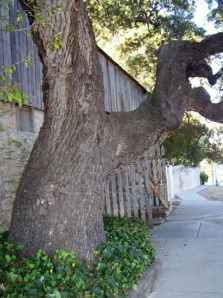I suppose it does seem a little like magic, this storytelling thing. Explaining it even to yourself – much less to other people usually results in bafflement. Like the old joke about dissecting humor being like dissecting a frog – by the time you are done, there is nothing but a bit of a mess and confusion and the frog is dead anyway. My parents, as practical and hard-headed people, were as puzzled by this aptitude as anyone else – they couldn’t for the life of them figure out how I came by the gift of spinning an enthralling story, of creating people on a page and making them so interesting and endearing that eventually they became quite invested in my characters. More »
Ok, so the look-inside feature isn’t bolted on yet, but the Adelsverein Complete Trilogy has gone live at Amazon and Barnes & Noble, as of yesterday – and in Kindle and Nook editions. Now that it’s well-launched, I’m back to the next two projects: the sequel to Daughter of Texas – which will be called Deep in the Heart and be ready for launch at the New Braunfels Weihnachtsmarkt, which will be held at the end of November. And just in case there is not quite enough to on all of that, Watercress Press is going to do a second print edition of To Truckee’s Trail . . . which I have wanted to do, both because it would be at Watercress and at a slightly lower retail price than previously . . . and because I had found out from a descendent of one of the real-life people that I wrote about – that he had actually been to California two decades before crossing the Sierra Nevada with the Stephens-Townsend Party in 1844. The character of Old Man Hitchcock, the mountain man and fur-trapper was painted as an entertaining teller of tall tales . . . but in this one instance he had been telling the absolute truth. So – the second edition in print will be out by mid-October. And one last thing – I’ve been asked, in person and via email, if there wasn’t a way to have the Adelsverein Trilogy translated into a German edition, as there would be a terrific audience among all those Karl May fans, who absolutely eat up anything to do with adventures in the 19th century American west. Anyone know anyone in the literary agent world who pitches to German-language publishers, and wants to negotiate rights to a German translation of the Trilogy? Any agent looking to explore that option would make out like a bandit, even at 15%. Fortunes in the book-world these days favor the nimble. It may be a bit of a niche market relative to American publishing – but owning a large chunk of a niche market is not bad.
 He really wore a black hat, this particular villain; he was known and recognized throughout the district around Fredericksburg and the German settlements in Gillespie County – by his fine, black beaver hat. Which was not furry, as people might tend to picture immediately – but made of felt, felt manufactured from the hair scraped from beaver pelts. This had been the fashion early in the 19th century, and made a fortune for those who sent trappers and mountain-men into the far, far west, hunting and trapping beaver. The fashion changed – and the far-west fur trade collapsed, but I imagine that fine hats were still made from beaver felt. And J.P. Waldrip was so well-known by his hat that he was buried with it.
He really wore a black hat, this particular villain; he was known and recognized throughout the district around Fredericksburg and the German settlements in Gillespie County – by his fine, black beaver hat. Which was not furry, as people might tend to picture immediately – but made of felt, felt manufactured from the hair scraped from beaver pelts. This had been the fashion early in the 19th century, and made a fortune for those who sent trappers and mountain-men into the far, far west, hunting and trapping beaver. The fashion changed – and the far-west fur trade collapsed, but I imagine that fine hats were still made from beaver felt. And J.P. Waldrip was so well-known by his hat that he was buried with it.
There is not very much more known about him, for certain. I resorted to making up a good few things, in making him the malevolent presence that he is in The Adelsverein Trilogy – a psychopath with odd-colored eyes, a shifty character, suspected of horse-thievery and worse. I had found a couple of brief and relatively unsubstantiated references to him as a rancher in the Hill Country, before the Civil War, of no fixed and definite address. That was the frontier, the edge of the white man’s civilization. Generally the people who lived there eked out a hardscrabble existence as subsistence farmers, running small herds of near-wild cattle. There was a scattering of towns – mostly founded by the German settlers who filled up Gillespie the late 1840s, and spilling over into Kendall and Kerr counties. The German settlers, as I have written elsewhere, brought their culture with them, for many were educated, with artistic tastes and sensibilities which contrasted oddly with the comparative crudity of the frontier. They were also Unionists, and abolitionists in a Confederate state when the Civil War began – and strongly disinclined to either join the Confederate Army, or take loyalty oaths to a civil authority that they detested. Within a short time, those German settlers were seen as traitors, disloyal to the Southern Cause, and rebellious against the rebellion. They paid a price for that; martial law imposed on the Hill Country, and the scourge of the hangerbande, the Hanging Band. The Hanging Band was a pro-Confederate lynch gang, which operated at the edges of martial and perhaps with encouragement of local military authorities.
J.P. Waldrip was undoubtedly one of them – in some documents he is described as a captain, but whether that was a real military rank, or a courtesy title given to someone who raised a company for some defensive or offensive purpose remains somewhat vague. None the less, he was an active leader among those who raided the settlements along Grape Creek, shooting one man and hanging three others – all German settlers, all of them of Unionist sympathies. One man owned a fine horse herd, another was known to have money, and the other two had been involved in a land dispute with pro-Confederate neighbors. Waldrip was also recognized as being with a group of men who kidnapped Fredericksburg’s schoolteacher, Louis Scheutze, from his own house in the middle of town, and took him away into the night. He was found hanged, two days later – his apparent crime being to have objected to how the authorities had handled the murders of the men from Grape Creek. It was later said bitterly, that the Hanging Band had killed more white men in the Hill Country during the Civil War than raiding Indians ever did, before, during and afterwards.
And two years after the war ended, J.P. Waldrip appeared in Fredericksburg. No one at this date can give a reason why, when he was hated so passionately throughout the district, as a murderer, as a cruel and lawless man. He must have known this, known that his life might be at risk, even if the war was over. This was the frontier, where even the law-abiding and generally cultured German settlers went armed. Why did he think he might have nothing to fear? Local Fredericksburg historians that I put this question to replied that he was brazen, a bully – he might have thought no one would dare lift a hand against him, if he swaggered into town. Even though the Confederacy had lost the war, and Texas was under a Reconstruction government sympathetic to the formerly persecuted Unionists – what if he saw it as a dare, a spit in the eye? Here I am – what are y’all going to do about it?
What happened next has been a local mystery ever since, although I – and the other historical enthusiasts are certain that most everyone in town knew very well who killed J.P. Waldrip. He was shot dead, and fell under a tree at the edge of the Nimitz Hotel property. The tree still exists, although the details of the story vary considerably: he was seen going into the hotel, and came out to smoke a quiet cigarette under the tree. No, the shooter saw him going towards the hotel stable, perhaps to steal a horse. No, he was being pursued by men of the town, after the sheriff had passed the word that he was an outlaw, and that anyone killing him would face no prosecution from the law. Waldrip was shot by a sniper, from the cobbler’s shop across Magazine Street — no, he was shot from the upper floor of another building, diagonally across Main Street. He was felled by a single bullet and died instantly, or was shot many times and lived long enough to plead “Please don’t shoot me any more”. I have created yet another rationale for his presence, and still another dramatic story of his end under the oak tree next to the Nimitz Hotel. I have a feeling this version will, over time be added to the rest. Everyone who knew the truth about who shot Waldrip, why he came back to town, how the town was roused against him, and what happened afterwards, all those people took the knowledge of those matters to their own graves, save for tantalizing hints left here and there for the rest of us to find. The whole matter about the two men who may have actually fired the shot — or shots — was kept secret for decades, for fear of reprisals from those of his friends and kin who had survived the war. This was Texas, after all, where feuds and range wars went on for generations.
So James P. Waldrip was buried – with his hat – first in a temporary grave, not in the town cemetery – and then moved to a secret and ignominious grave on private property. The story is given so that none of his many enemies might be tempted to desecrate it, but I think rather to make his ostracism plain and unmistakable, in the community which he and his gang had persecuted.


Recent Comments